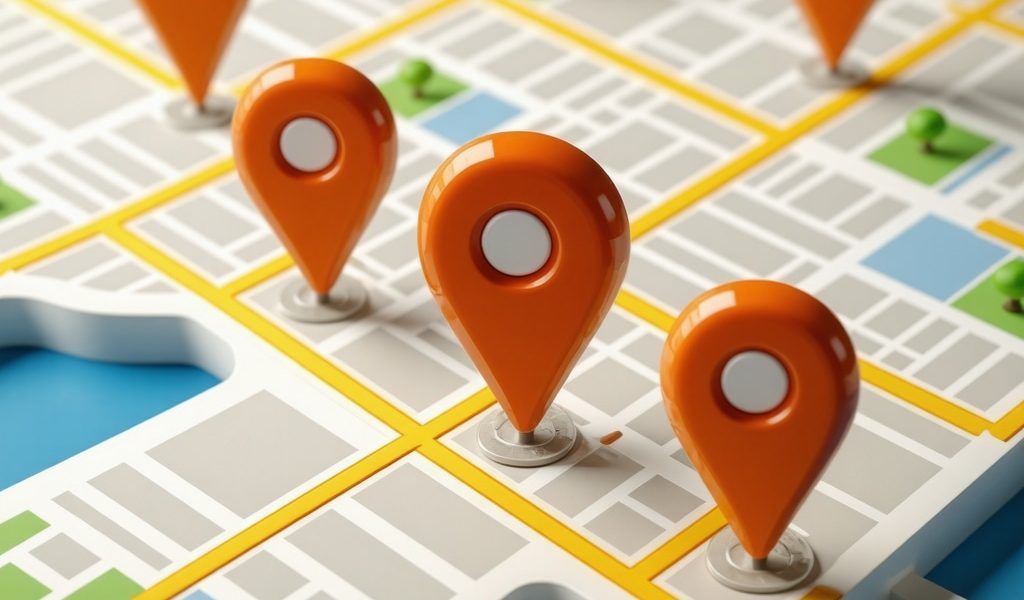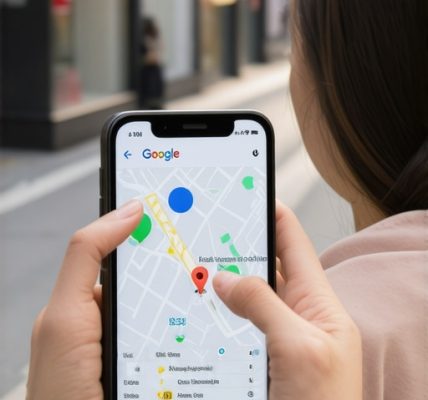Unlocking the Power of Google Maps: Why Fast Ranking Matters for Local Enterprises
In today’s hyperconnected world, local businesses thrive or dive based on their visibility in Google Maps. Rapidly climbing the ranks here isn’t just a vanity metric; it translates directly into foot traffic, calls, and sales. Many entrepreneurs overlook that Google Maps optimization demands a distinct, strategic approach beyond traditional SEO. This article unveils proven tips to rank fast in Google Maps for local businesses, blending expert insight with actionable tactics that deliver tangible results.
Crafting a Magnetic Google Business Profile That Captures Attention
Your Google Business Profile (GBP) acts as the digital storefront on Maps. To ascend quickly, precision and completeness in your listing are paramount. Ensure every detail—from business name and address to hours and categories—is accurate and consistent with your website and other citations. Incorporate LSI keywords naturally within your business description to enhance semantic relevance. For instance, a bakery might include terms like “artisan bread,” “local pastries,” and “freshly baked goods.” High-quality images and regular posts enrich the profile’s appeal and signal active engagement to Google’s algorithms.
Strategic Local Citations: Building Authority and Trust in the Neighborhood
Consistent citations across authoritative local directories bolster your Google Maps rankings by reinforcing your business’s legitimacy. Leveraging expert GMB citation services can accelerate this process, ensuring your NAP (Name, Address, Phone) information is flawlessly uniform. These citations act as trust signals, especially when they appear on high-domain authority sites relevant to your niche and locale.
How Do Customer Reviews Influence Rapid Ranking on Google Maps?
Customer reviews are the lifeblood of local SEO. They not only impact consumer trust but also Google’s local ranking factors. Encouraging genuine, positive reviews with detailed feedback creates a rich content ecosystem around your listing. Respond promptly and thoughtfully to all reviews, demonstrating active customer engagement. Studies by Moz highlight that review quantity, velocity, and diversity significantly affect local pack rankings. Integrating review generation best practices can propel your business ahead of competitors.
Optimizing for ‘Near Me’ Searches: Capturing Intent-Driven Local Traffic
Modern consumers often include “near me” in their queries, reflecting high purchase intent. Tailoring your Google Maps SEO to target these hyperlocal searches involves embedding relevant location-based keywords and ensuring your business is verified and active on Google. Tools like Google Keyword Planner can uncover trending local search terms to weave into your GBP and website content, enhancing your discoverability for critical intent-driven queries.
Engagement Signals and Fresh Content: The Secret Ingredients to Sustain Momentum
Regularly updating your Google Business Profile with posts, offers, and Q&A sections signals to Google that your business is active and relevant. This dynamic content can increase user engagement, improve click-through rates, and foster higher rankings. Additionally, integrating Google Maps SEO best practices such as optimized photos and real-time updates can differentiate your profile in competitive local markets.
If you’re looking to deepen your understanding and apply comprehensive tactics, check out the ultimate guide to Google Maps SEO that goes beyond basics to elevate your local search strategy.
Do you have experiences or questions about fast-tracking your Google Maps ranking? Share your thoughts and insights below to join a vibrant community of local SEO enthusiasts!
Leveraging Google My Business Insights for Smarter Optimization
One of the most eye-opening experiences I’ve had optimizing Google Maps rankings was when I started diving deep into the data provided by Google My Business (GMB) Insights. Initially, I only glanced at basic metrics like views and clicks, but over time, I realized that these insights offered a treasure trove of actionable information. For instance, understanding how customers find your business—whether through direct search, discovery, or branded search—can guide where to focus your efforts.
By analyzing the queries that triggered my listing, I could refine my business description and posts to better align with real user intent. I also paid attention to customer actions such as calls, website visits, and direction requests. These signals not only reflect engagement but can influence your ranking as Google interprets them as indicators of relevance and popularity.
Incorporating a weekly routine to review GMB Insights has become a cornerstone of my strategy. With that data in hand, I could tweak my review generation approach and posting schedule, which resulted in noticeable improvements in local search visibility.
Why Do Some Businesses Rank Faster Than Others on Google Maps?
From my experience, the speed at which a business climbs the Google Maps ranking ladder hinges on several intertwined factors. Beyond the usual suspects like accurate NAP citations and positive reviews, local competition plays a huge role. I’ve seen businesses in less saturated niches or smaller towns achieve top rankings within weeks, while those in crowded urban environments might take months despite similar efforts.
Another factor is how well a business taps into community engagement. For example, sponsoring local events or collaborating with nearby businesses can lead to natural citations and backlinks, which Google values highly. I once worked with a local cafe that partnered with a community theater, and the resulting online buzz and mentions significantly boosted their local authority.
What’s the secret sauce to gaining genuine, high-quality reviews without feeling pushy?
This question comes up a lot when I chat with other local business owners. The key, I’ve found, is to integrate review requests seamlessly into the customer journey. For instance, after a positive interaction, I encourage staff to politely ask customers if they’d be willing to share their experience online, emphasizing how it helps the business grow and serve the community better.
Offering simple, user-friendly links via text or email makes it easy for customers to leave feedback without hassle. Also, responding sincerely to every review—whether glowing or critical—builds trust and encourages more people to engage. Over time, this strategy not only boosts your Google Maps ranking but also fosters a loyal customer base.
Integrating External Resources to Enhance Your Local SEO Strategy
While personal experience is invaluable, I also lean on well-researched external insights to sharpen my approach. For example, Moz’s comprehensive analysis of local search ranking factors helped me understand the relative weight of elements like proximity, relevance, and prominence in Google’s algorithm. This knowledge allows me to prioritize tactics that make the biggest difference, such as optimizing for “near me” searches and maintaining consistent citations.
If you’re eager to dive deeper, exploring resources like Understanding Local SEO for Small Businesses can provide a structured framework to complement hands-on efforts. Combining real-world testing with solid research creates a powerful synergy that accelerates local SEO success.
I’d love to hear how you’ve tackled your Google Maps ranking challenges or any unique strategies you’ve discovered. Feel free to share your experiences or questions below—let’s learn from each other and grow together in this exciting local SEO journey!
Decoding Behavioral Analytics: How User Interaction Data Shapes Google Maps Rankings
While foundational optimization tactics such as NAP consistency and review acquisition are critical, a deeper layer of Google’s ranking algorithm involves analyzing user behavioral signals. Metrics like click-through rate (CTR) on your Google Business Profile, the number of direction requests, and even how long users engage with your listing can profoundly influence your local ranking trajectory.
For instance, if your listing receives a high volume of clicks but minimal subsequent engagement (e.g., no calls or visits), Google’s algorithm might interpret this as less relevant to the search intent, dampening your ranking over time. Conversely, consistent and meaningful interactions signal strong relevance and user satisfaction, which Google rewards by boosting your visibility.
To optimize these behavioral signals, ensure your profile is compelling with clear call-to-actions (CTAs) and that your offered services or products align tightly with local demand. Integrating booking or inquiry features directly within your profile can also increase conversion rates, enhancing positive engagement metrics.
Harnessing Google’s Algorithm Updates: Staying Ahead Amid Continuous Change
Google’s local search algorithm is continuously evolving, integrating machine learning models that refine how business relevance, proximity, and prominence are weighted. Staying current with these updates is paramount for maintaining and accelerating your Google Maps ranking.
For example, the introduction of the Vicinity Update emphasized the importance of geographical closeness, subtly shifting the balance toward hyperlocal relevance. Meanwhile, advancements in natural language processing (NLP) allow Google to better understand the semantic context of your business description, reviews, and posts.
To adapt, incorporate semantically rich content that addresses user queries comprehensively. Employ tools like Google Search Console’s Performance report combined with GMB Insights to detect shifts in user behavior and search patterns promptly. Proactively adjusting your content strategy based on these insights can buffer against ranking volatility caused by algorithmic changes.
How Can Advanced Citation Strategies Amplify Authority Beyond Basic NAP Consistency?
Beyond simply ensuring consistency, advanced citation strategies involve selecting citation sources with strategic intent and leveraging structured data markup. High-authority niche directories, local chamber of commerce sites, and industry-specific portals can provide significant domain authority signals.
Moreover, embedding schema.org LocalBusiness markup on your website helps Google parse your business details more effectively, enhancing your profile’s trustworthiness and potentially influencing Maps rankings. Coupling this with periodic citation audits — checking for outdated or duplicate listings — maintains a clean and authoritative citation footprint that supports rapid ranking gains.
Integrating Behavioral and Algorithmic Insights for a Holistic Ranking Strategy
The intersection of user behavior analytics and algorithmic evolution creates a dynamic environment for Google Maps SEO. By uniting data-driven engagement optimizations with adaptive content and citation strategies, local businesses can unlock faster and more sustainable ranking improvements.
Tools such as BrightLocal’s GMB Insights Analysis provide granular behavioral data, enabling precision tweaks that amplify user engagement. This granular approach transcends basic optimization, transforming your Google Business Profile into a powerful conversion engine aligned with evolving search algorithms.
If you’re ready to elevate your local SEO efforts, start by auditing your user engagement metrics and citation quality today. Experiment with enriched content, interactive features, and structured data implementation to differentiate your business in the competitive local search landscape.
Do you have advanced tactics or experiences optimizing behavioral signals and adapting to algorithm updates? Share your insights below and become part of an expert community pushing the boundaries of Google Maps SEO!
Decoding the Impact of User Engagement Metrics on Google Maps Ranking Algorithms
Delving deeper into the realm of behavioral analytics reveals how nuanced user interactions can dramatically shift your Google Maps ranking. Beyond traditional factors, metrics such as the click-through rate (CTR), frequency of direction requests, and duration of user engagement provide Google with critical signals about your business’s relevance and appeal. A profile that prompts meaningful interactions—like actual visits or calls—demonstrates tangible value to prospective customers and, consequently, earns higher algorithmic favor.
To harness this, businesses should embed clear, compelling call-to-actions across their Google Business Profile, ensuring seamless pathways for users to engage. Incorporating features such as direct booking or inquiry forms within the profile can significantly boost these engagement metrics, aligning user intent with conversion opportunities and enhancing your local search prominence.
How can integrating structured data and advanced citation auditing accelerate Google Maps rankings beyond standard practices?
While consistent NAP citations remain foundational, leveraging structured data markup like schema.org LocalBusiness enables search engines to more effectively interpret your business details, thus reinforcing trustworthiness and relevance. Coupled with a strategic selection of high-authority, niche-specific citation sources, this approach amplifies your local authority signals.
Regular citation audits are equally crucial to identify and rectify discrepancies such as outdated or duplicate listings, which can dilute your ranking potential. Advanced citation management—focusing on quality over quantity—positions your business optimally within competitive local search ecosystems.
Staying Adaptive: Navigating Google’s Local Algorithm Updates with Agile Content Strategies
Google’s local search ecosystem is in constant flux, driven by sophisticated machine learning advancements and updates like the Vicinity Update. These shifts necessitate an agile SEO approach that embraces semantic richness and user intent alignment. Crafting content that addresses comprehensive user queries, enriched with latent semantic indexing (LSI) terms and locally relevant nuances, is essential to maintain and improve rankings amidst evolving algorithmic criteria.
Employing tools such as Google Search Console alongside Google My Business Insights facilitates real-time monitoring of search trends and user behaviors, enabling timely content pivots. This proactive stance helps mitigate ranking volatility and ensures your Google Business Profile remains a dynamic, authoritative presence in local search results.
Expert Strategies to Leverage Third-Party Behavioral Analytics Tools for Enhanced Local SEO
Integrating third-party platforms like BrightLocal’s GMB Insights Analysis offers granular visibility into user interaction patterns beyond native Google dashboards. These insights empower local businesses to implement precision optimizations—fine-tuning posting schedules, refining service descriptions, and enhancing visual content—to maximize engagement and conversion rates.
Employing such tools facilitates a holistic understanding of your profile’s performance ecosystem, from impression trends to customer behavior flows, enabling data-driven decisions that elevate your Google Maps presence sustainably.
Ready to transform your local SEO approach with cutting-edge behavioral analytics and advanced citation tactics? Engage with these expert insights and share your experiences to join a community dedicated to pioneering Google Maps optimization excellence.
Frequently Asked Questions (FAQ)
How long does it typically take to rank fast on Google Maps for a new local business?
Ranking speed varies widely depending on factors such as competition density, citation consistency, review quality, and profile optimization. In less competitive markets, businesses can see top rankings within weeks, while in saturated urban areas, it might take several months despite best practices. Continuous engagement and data-driven optimization accelerate this timeline.
What role do customer reviews play in influencing Google Maps rankings?
Customer reviews are pivotal for local SEO. Google values review quantity, diversity, and velocity, as well as the sentiment and engagement in responses. Genuine, detailed reviews enhance trust signals and semantic relevance, boosting ranking potential. Prompt, thoughtful replies foster customer loyalty and further signal active business management.
Why is NAP consistency critical, and how do advanced citation strategies improve upon it?
NAP (Name, Address, Phone) consistency ensures Google correctly associates your business across platforms. Advanced citation strategies involve selecting high-authority, niche-relevant directories and employing structured data markup like schema.org LocalBusiness to enhance machine readability. Regular citation audits prevent outdated or duplicate listings, preserving authority and accelerating rankings.
How can integrating behavioral analytics improve my Google Maps ranking?
Behavioral analytics track user interactions such as click-through rate, direction requests, and engagement duration. High-quality interactions indicate relevance and user satisfaction to Google’s algorithm, positively influencing rankings. Optimizing your profile with clear CTAs, booking options, and relevant content maximizes these engagement signals, creating a virtuous ranking cycle.
What strategies help optimize for ‘near me’ and intent-driven local searches?
Targeting “near me” queries requires embedding precise location-based keywords and ensuring your Google Business Profile is verified and active. Leveraging tools like Google Keyword Planner to identify trending local search terms and incorporating them naturally into your business description and posts enhances discoverability for intent-rich queries.
How do Google algorithm updates like the Vicinity Update affect local SEO?
Updates such as the Vicinity Update emphasize hyperlocal relevance by increasing the weight of geographic closeness in rankings. These algorithmic shifts require agile SEO strategies that incorporate semantic content, address comprehensive user queries, and monitor search trends closely, ensuring your profile aligns with evolving ranking criteria.
What is the significance of using structured data markup for Google Maps optimization?
Structured data markup like schema.org LocalBusiness helps search engines accurately parse your business information, enhancing profile trustworthiness and relevance. This can improve the visibility of your profile in local search results and support richer search features, contributing to faster and more sustainable rankings.
Can third-party tools enhance my understanding of Google Business Profile performance?
Yes. Platforms such as BrightLocal’s GMB Insights Analysis provide granular behavioral data beyond native Google dashboards. These tools reveal detailed user interaction patterns, enabling targeted optimizations in posting schedules, service descriptions, and visual content that elevate engagement and local search performance.
How can I encourage genuine, high-quality customer reviews without seeming pushy?
Integrate review requests naturally into the customer journey, such as after a positive interaction or purchase. Provide simple, accessible review links via text or email, and explain how reviews help improve service for the community. Always respond sincerely to all reviews, which builds trust and encourages ongoing customer participation.
Are community engagement and local partnerships important for faster Google Maps ranking?
Absolutely. Active community involvement and partnerships generate natural citations, backlinks, and online buzz that enhance your local authority. Collaborations with local events or businesses create authentic signals valued by Google, contributing to quicker and more durable ranking improvements.
Trusted External Sources
- Moz Local Search Ranking Factors – Offers comprehensive, research-backed insights into the relative importance of various local SEO elements, including reviews, citations, and behavioral signals.
- BrightLocal’s Google My Business Insights Analysis – Provides advanced analytics and industry benchmarks that enable precise understanding of user engagement patterns and optimization opportunities.
- Google’s Official Local SEO Documentation and Guidelines – The primary source for best practices and updates directly from Google, critical for aligning strategies with algorithmic expectations.
- Search Engine Journal and Search Engine Land – Leading industry publications that cover algorithm updates, expert case studies, and evolving SEO tactics relevant to Google Maps optimization.
- Schema.org LocalBusiness Markup Documentation – Authoritative resource detailing structured data implementation which enhances search engine comprehension of business details.
Conclusion: Elevate Your Local Business with Rapid Google Maps Ranking Techniques
Achieving fast ranking on Google Maps demands a multifaceted, expert-informed approach that blends precise profile optimization, strategic citation management, and proactive engagement with evolving algorithm dynamics. Prioritizing NAP consistency, cultivating high-quality reviews, and leveraging behavioral analytics unlock the full potential of your Google Business Profile as a powerful local marketing asset.
Staying agile in response to Google’s continuous updates—by enriching content semantically, auditing citations rigorously, and harnessing third-party insights—ensures your business not only climbs the ranks quickly but sustains prominence in competitive local landscapes.
Empower your local SEO strategy today by applying these advanced tactics and engaging with the vibrant community of experts and entrepreneurs shaping the future of Google Maps optimization. Share your experiences, explore further expert content, and transform your visibility into tangible business growth.



